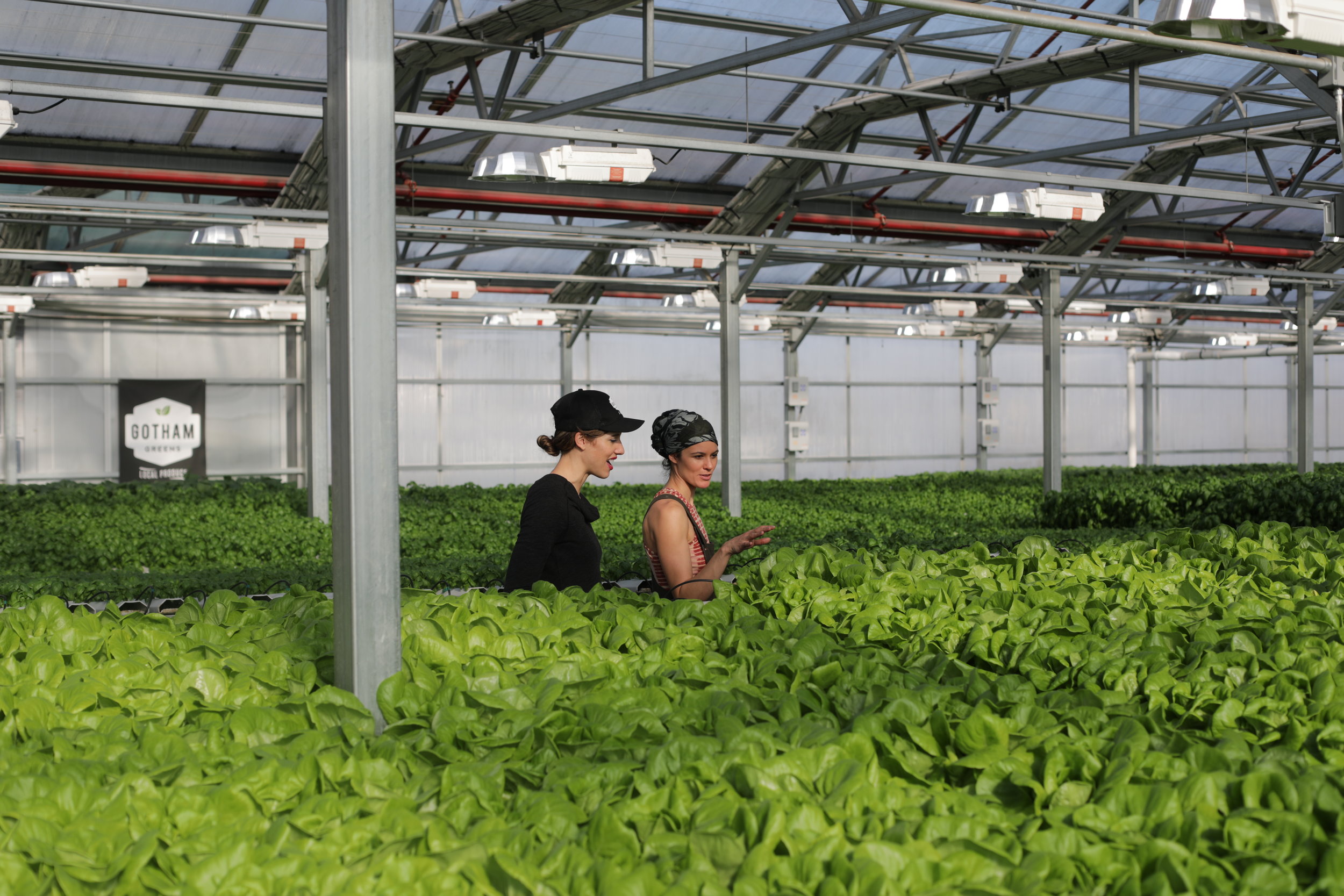It may be winter outside, but it's a balmy 70°F in the Gotham Greens rooftop greenhouse in Greenpoint where a half acre of butterhead, basil, bok choy and oak leaf lettuce grows. This is the "OG Gotham Greens"—their original location, which holds the record for the first commercial scale hydroponic rooftop farm in the U.S.
Now with three locations (two in New York, one in Chicago) and soon to be four (so says Nicole Baum, Senior Marketing Manager), Gotham Greens is showing how hydroponics can and should have a presence in urban agriculture. Gotham Greens picks, packs and sends their pesticide-free salad greens and herbs same-day directly to surrounding grocery stores, like Whole Foods, all while using 20-30X less energy. This ensures the greens are fresh, which is imperative, considering that leafy greens have a max shelf life of 2 weeks and are currently being sourced in drought-stricken places like California and Arizona. We not only had a chance to go see Gotham Greens for one of the latest episodes of Plant One On Me, but also got to speak with Nicole more at length below.
Nicole Baum of Gotham Greens took us on tour of the first commercial hydroponic rooftop farm in the U.S.
Summer Rayne Oakes: What was the inspiration behind starting Gotham Greens?
Nicole Baum: Our founders were inspired by innovation and technology, and driven by a sense of duty to address ecological issues facing our agricultural system. It was the winter of 2009 in NYC and they realized that most of the produce they were finding in the supermarkets was coming from places like Mexico, California, and Israel. They realized that by the time the produce made its way to NYC, it was at least a week old and had changed hands multiple times. They also began to notice that consumer preferences were shifting toward more local and sustainably produced food. The goal was to create a sustainable farming company that could revolutionize the notion of how fresh local produce could be grown and distributed, while making a profound positive impact on inner city communities and the environment.
Gotham Greens built our first rooftop greenhouse in Greenpoint, Brooklyn in 2011 and within the first few months, we were completely sold out and had attracted retailers like Whole Foods Market and celebrated chefs like Chef Michael Anthony of Gramercy Tavern. This new model of hyper local urban farming meant that we could harvest our leafy greens and herbs in the morning, package everything on site and deliver directly to supermarkets and restaurants that same day, 365 days a year. Gotham Greens now has 4 commercial scale rooftop greenhouse in NYC and Chicago and our packaged salads, herbs and pesto can be found at most major supermarkets as well as neighborhood grocers and restaurants throughout NYC and Chicago.
This little basil is growing through NFT, using nutrients in water vs. a soil-based system.
SRO: Expand upon a little more of why you do what you do.
NB: My background is not in farming but I joined Gotham Greens back in 2014 because I was inspired by the company’s mission and saw the enormous potential it had to change the way people access fresh produce in cities. One of my favorite parts of my job has been building out our community partnerships with local non-profits like the New York City and Chicago Parks Departments. We donate tens of thousands of plants to public schools and community gardens each year, which are used in environmental education and wellness programs. We also partner with food recovery organizations like City Harvest and The Greater Chicago Food Depository to help us distribute fresh produce to folks within our communities who face food insecurity.
SRO: What attracted you to hydroponics in the first place?
NB: Hydroponic farming, when practiced effectively, can be very efficient, using a fraction of the amount of resources as traditional farming practices. If done well, it can also allow complete control over plant nutrition, for optimal flavor and quality.
SRO: What type of hydroponic systems do you employ?
NB: At Gotham Greens, we use advanced, re-circulating hydroponic techniques to maintain precision plant nutrition. This enables us to use 1/10th the amount of water as traditional soil based practices, while also eliminating all agricultural runoff. Our pesticide-free produce is grown using ecologically sustainable methods in 100% renewable electricity-powered urban rooftop greenhouses. This is especially pertinent given natural resource constraints, persistent drought, and related adverse impacts on the environment including agricultural runoff, one of the leading causes of global water pollution.
Fields of green at Gotham Greens—this location provides 20X the amount of greens than the equivalent area of land in a soil-based system.
SRO: What produce do you specialize in and where and who do you sell your produce?
NB: We grow local, leafy greens and herbs in high tech, climate controlled greenhouses, year-round. That means, even in the dead of winter, we provide our customers— supermarkets, restaurants, caterers—with fresh produce within a couple of hours of harvest. A little over a year ago we also launched a line of fresh pesto made from our Genovese Basil. It’s grown a bit of a cult following and we recently expanded the line to include Classic, Vegan and Spicy varieties.
SRO: How much produce/greens do you produce in a given year? How does that compare to the same size soil-based farm during the growing season in similar climate zone?
NB: Our advanced growing methods yield 20-30 times more product per acre than field production, while eliminating any use of arable land. Our 170,000 square feet of greenhouses across the four facilities produce yields equivalent to over 100 acres of conventional field farming.
SRO: Now that you’ve been at this for around 9 years, what were some of the most important learnings along the way?
NB: Starting any business is extremely challenging, but for most businesses, there are at least a couple of models to use as a point of reference. In 2011 when we were designing our flagship Brooklyn greenhouse, there was no blueprint to follow, so we had to learn as we went along. There was no precedent for what we were trying to pull off. People thought we were crazy when we told them we wanted to build large-scale greenhouses on city roofs. Over the years we’ve learned a lot about finding the right real estate and landlord, navigation regulatory challenges (zoning, permitting, etc.) and the myriad of logistics that go into running a food production facility and distributing your own produce.
The beauty of hydroponic basil at Gotham Greens on their rooftop greenhouse farm in Greenpoint, Brooklyn.
SRO: Hydroponics have become quite popular in the city since you first started. Why is that? And what is the importance of that?
NB: It’s awesome to see the different models of urban farming that have sprouted up, even in the last five years. We don’t necessarily look at them as competition, we’re all working towards a more sustainable alternative to the industrially produced greens that are being shipped across the country. If you look at the stats, 98% of the lettuces and herbs that are grown in this country are still coming from 2 states- California and Arizona! Both of those states also happen to be experiencing extreme drought…that’s crazy to me.
Many of the folks we’re now seeing in the urban agriculture space are growing 100% indoor and rely completely on artificial light and HVAC systems. One of the major differences between our models is that Gotham Greens primarily uses natural sunlight with some supplemental lighting in the winter months. As a result, we’re using much less energy and the result is a better quality product. We remain opportunistic to new types of technology and LEDs, but we’ve found that there’s still no comparison to the natural sunlight and the products it yields.
Laughing out loud in Gotham Greens' original greenhouse location in Greenpoint, Brooklyn.
SRO: What’s your vision of a food future in urban centers?
NB: I believe that hydroponics will continue to play a greater role in the future of a more sustainable, secure and just global agricultural system. That being said, the commercial viability of current hydroponic technology is limited to highly perishable, high value, vegetables, fruit, and herbs and does not currently play in role in producing other agricultural staples like grains, proteins, root vegetables, fruit, and others.
Gotham Greens has helped pioneer the field of urban agriculture and we’re very optimistic that this form of farming can play a strong role in a more diverse and sustainable food system. That being said, we also feel that the sector is still in its infancy and has a ways to go to become viable commercially on a wide scale. Gotham Greens is one successful example but the industry needs to mature before we proclaim that it is a panacea, or even a partial answer, to the significant ecological, public health and economic concerns facing our current food system.
SRO: How can the public learn more about Gotham Greens? Do you ever do any public tours?
NB: Come check out our weekly tours at our rooftop greenhouse in Gowanus on top of Whole Foods Market. It’s an outdoor space so it’s weather pending but every April- November we host FREE tours every week where you can check out our farm and try our products. We’ve also recently launched tours on Airbnb Experiences where folks can check out the farm and enjoy a beer with one of our growers.







